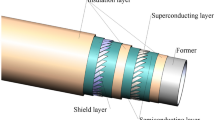Abstract
This paper presents a type of high temperature superconducting (HTS) cable, which is fabricated by winding the second generation (2G) HTS tapes on round former consisting of stranded stainless steel (SS) wires. It has the advantages of strong flexibility, high mechanical strength, and high engineering current density. With taking the resistivity of SS much larger than that of copper or aluminum, the cable has higher resistance and strength than the conventional HTS cable with former made from copper strands at condition of fault accident. After the configuration of the cable is designed in detail, the quenching resistance and fault current limiting are numerically analyzed. We fabricate a model cable and carry out the experiment of fault current. The experimental results show that the quenching resistance of this cable is much higher than the resistance of conventional underground XLPE cable and overhead conductor, which indicates that the proposed cable has a strong ability of fault current limiting and can be applicable in HTS devices with functions of fault current limiting such HTS cable, transformer, motor/generator, and current limiter.















Similar content being viewed by others
References
Kovalsky, L., et al.: Applications of superconducting fault current limiters in electric power transmission systems. IEEE Trans. Appl. Supercond. 15, 2130–2133 (2005)
Noe, M., Oswald, B.R.: Technical and economical benefits of superconducting fault current limiters in power systems. IEEE Trans. Appl. Supercond. 9, 1347–1350 (1999)
Ohtsubo, Y., et al.: Development of REBCO superconducting transformers with a current limiting function fabrication and tests of 6. 9 kV - 400 kVA transformers. IEEE Trans. Appl. Supercond. 25, 5505305 (2014)
Hellmann, S., et al.: Manufacturing of a 1-MVA-class superconducting fault current limiting transformer with recovery-under-load capabilities. IEEE Trans. Appl. Supercond. 27, 5500305 (2017)
Gouge, M.J., et al.: Testing of 3-meter prototype fault current limiting cables. IEEE Trans. Appl. Supercond. 19, 1744–1747 (2009)
Zhu, J., et al.: Magneto-thermal coupling modeling for the stability analysis of a 110 kV/3 kA high temperature superconducting cable under fault current conditions. J. Supercond. Nov. Magn. 28, 607–613 (2015)
Kozak, J., et al.: Design and tests of coreless inductive superconducting fault current limiter. IEEE Trans. Appl. Supercond. 22, 5601804 (2012)
Hayakawa, N., et al.: Progress in development of superconducting fault current limiting transformer (SFCLT). IEEE Trans. Appl. Supercond. 21, 1397–1400 (2010)
Takayasu, M., et al.: Conductor characterization of YBCO twisted stacked-tape cables. IEEE Trans. Appl. Supercond. 23, 4800104 (2013)
Wang, J., et al.: Bending characteristics if a quasi-isotropic HTS conductor with high engineering current density. J. Supercond. Nov. Magn. 3, 3001–3007 (2020)
Bruzzone, P., et al.: Test results of a Nb3Sn cable-in-conduit conductor with variable pitch sequence. IEEE Trans. Appl. Supercond. 19, 1448–1451 (2019)
Weiss, J.D., et al.: Introduction of CORC (R) wires: highly flexible, round high-temperature superconducting wires for magnet and power transmission applications. Supercond. Sci. Technol. 30, 014002 (2017)
Sytnikov, V.E., et al.: 30 m HTS power cable development and witness sample test. IEEE Trans. Appl. Supercond. 13, 1702–1705 (2009)
Olsen, S.K., et al.: Loss and inductance investigation in a 4-layer superconducting prototype cable conductor. IEEE Trans. Appl. Supercond. 9, 833–836 (1999)
Mukoyama, S., et al.: 50-m long HTS conductor for power cable. IEEE Trans. Appl. Supercond. 7, 1069–1072 (1997)
Mukoyama, S., et al.: Uniform current distribution conductor of HTS power cable with variable tape-winding pitches. IEEE Trans. Appl. Supercond. 9, 1269–1272 (1999)
Sytnikova, V.E., et al.: Influence of the multilayer HTS-cable conductor design on the current distribution. Physica C: Supercond. 310, 387–391 (1998)
Wang, Y., et al.: A conceptual design for HTS cable with large current capacity using co-axial configurations. IEEE Trans. Appl. Supercond. 20, 1263–1267 (2010)
Zhang, H., Zhang, M., Yuan, W.: An efficient 3D finite element method model based on the T–A formulation for superconducting coated conductors. Supercond. Sci. Technol. 30, 4005 (2016)
Wang, Y., et al.: Thermal behavior of quasi-isotropic strand and stacked-tape conductor. J. Supercond. Nov. Magn. 33, 3313–3319 (2020)
Wang, Y., et al.: Study of the magnetization loss of CORC(R) cables using a 3D T-A formulation. Supercond. Sci. Technol. 32, 5003 (2019)
Hemmi, T., et al.: Transient behavior of Bi2223/Ag HTS tape for sharp rising current. IEEE Trans. Appl. Supercond. 12, 1422–1425 (2002)
Czerwinski, D., et al.: Analysis of alternating overcurrent response of 2G HTS tape for SFCL. IEEE Trans. Appl. Supercond. 24, 5600104 (2014)
Yim, S., et al.: Electrical behavior of Bi-2223/Ag tapes under applied alternating over-currents. IEEE Trans. Appl. Supercond. 15, 2482–2487 (2005)
Liang, S., et al.: Study on quenching characteristics and resistance equivalent estimation method of second-generation high temperature superconducting tape under different overcurrent. Materials. 12, 2374 (2019)
Yasuda, M., et al.: Estimation of overcurrent performance in YBCO superconducting thin films for fault-current limiter. IEEE Trans. Appl. Supercond. 15, 2482–2487 (2005)
Wang, Y.: Fundamentals of superconducting power technology. China Science Publishing, Bei**g (2011)
Weber, C., et al.: Operating results of the Albany (NY) high temperature superconducting cable system, pp. 1–4. IEEE Power Engineering Society General Meeting, Tampa (2007)
Funding
This work was supported in part by the State Grid under Grant DG71-19-004.
Author information
Authors and Affiliations
Corresponding author
Additional information
Publisher’s note
Springer Nature remains neutral with regard to jurisdictional claims in published maps and institutional affiliations.
Rights and permissions
About this article
Cite this article
Kang, Q., Wang, Y., Qiao, Y. et al. Characterizations of a Novel Structure of Fault-Tolerant HTS Cable. J Supercond Nov Magn 34, 1147–1155 (2021). https://doi.org/10.1007/s10948-021-05825-x
Received:
Accepted:
Published:
Issue Date:
DOI: https://doi.org/10.1007/s10948-021-05825-x




